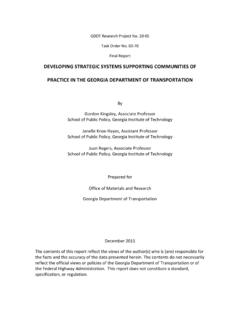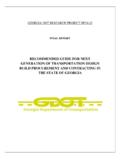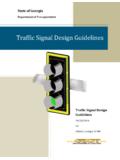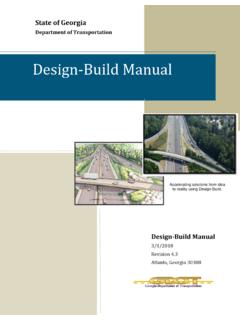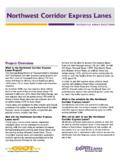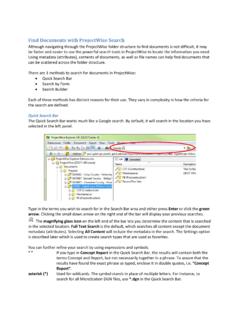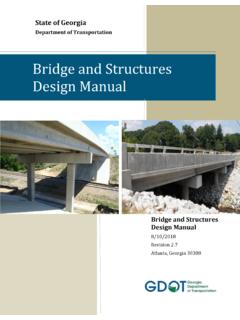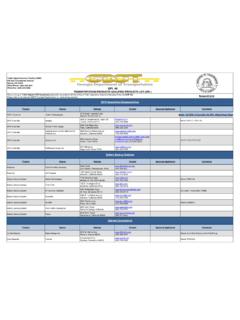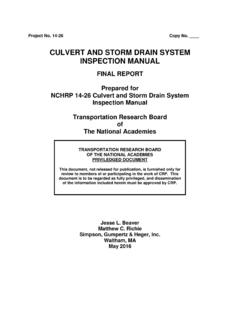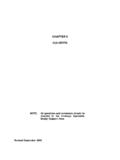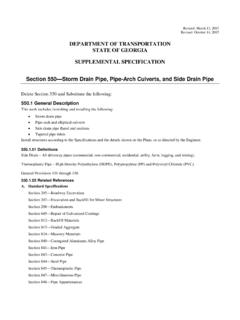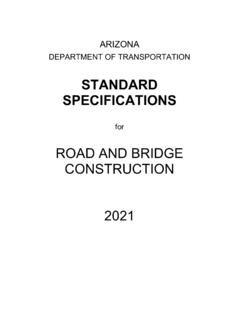Transcription of DEPARTMENT OF TRANSPORTATION STATE OF GEORGIA …
1 Revised: March 13, 2015 Revised: October 14, 2015 DEPARTMENT OF TRANSPORTATION STATE OF GEORGIA SUPPLEMENTAL SPECIFICATION Section 550 storm Drain Pipe, Pipe-Arch Culverts, and Side Drain Pipe Delete Section 550 and Substitute the following: General Description This work includes furnishing and installing the following: storm drain pipe Pipe-arch and elliptical culverts Side drain pipe flared end sections Tapered pipe inlets Install structures according to the Specifications and the details shown on the Plans, or as directed by the Engineer. Definitions Side Drain All driveway pipes (commercial, non-commercial, residential, utility, farm, logging, and mining). Thermoplastic Pipe High Density Polyethylene (HDPE), Polypropylene (PP) and Polyvinyl Chloride (PVC). General Provisions 101 through 150. Related References A. Standard Specifications Section 205 Roadway Excavation Section 207 Excavation and Backfill for Minor Structures Section 208 Embankments Section 645 Repair of Galvanized Coatings Section 812 Backfill Materials Section 815 Graded Aggregate Section 834 Masonry Materials Section 840 Corrugated Aluminum Alloy Pipe Section 841 Iron Pipe Section 843 Concrete Pipe Section 844 Steel Pipe Section 845 Thermoplastic Pipe Section 847 Miscellaneous Pipe Section 848 Pipe Appurtenances B.
2 Referenced Documents General Provisions 101 through 150. GDOT Manual on Drainage Design for Highways Ga. Std. 1030D Ga. Std. 1030P GDT 136 ASTM D 2321 Submittals General Provisions 101 through 150. Materials Ensure materials meet the requirements of the following Specifications: Material Section Backfill Materials 207 Graded Aggregate 815 Reinforced Concrete Pipe Nonreinforced Concrete Pipe Mortar And Grout Bituminous Plastic Cement Rubber Type Gasket Joints (Concrete Pipe) Preformed Plastic Gaskets Corrugated Steel Pipe Bituminous Coated Corrugated Steel Pipe Corrugated Aluminum Alloy Pipe Bituminous Coated Corrugated Aluminum Pipe Aluminized Type 2 Corrugated Steel Pipe Ductile Iron Pipe, Fittings and Joints 841 Precoated, Galvanized Steel Culvert Pipe Smooth Lined Corrugated High Density (HDPE) Polyethylene Culvert Pipe Polyvinyl Chloride (PVC) Profile Wall Drain Pipe Polyvinyl Chloride (PVC) Corrugated Smooth Interior Drain Pipe Smooth Lined Corrugated Polypropylene (PP) Pipe Miscellaneous Pipe 847 Use any of the following types of pipe.
3 Reinforced concrete Nonreinforced concrete Corrugated steel or Aluminum Smooth-lined corrugated high density polyethylene (HDPE) Ductile iron Polyvinyl Chloride (PVC) Profile Wall Drain Pipe Polyvinyl Chloride (PVC) Corrugated Smooth Interior Drain Pipe Polymer-Precoated Corrugated Steel Smooth Lined Corrugated Polypropylene (PP) Pipe Use the type of pipe designated on the Plans, or acceptable alternate types when applicable. For a listing of acceptable alternate pipe types see the GDOT Approved Material Selections List in Chapter 7 storm Drain Design of the DEPARTMENT s Manual on Drainage Design for Highways. This document summarizes general applications for pipe. For concrete, corrugated steel and aluminum pipes see Ga. Std. 1030D for minimum thicknesses, minimum cover, maximum fill, allowable pipe diameters and trench construction detail. For thermoplastic pipes see Ga. Std. 1030P for minimum cover, maximum fill, allowable pipe diameters and trench construction details.
4 Delivery, Storage, and Handling General Provisions 101 through 150. Construction Requirements Personnel General Provisions 101 through 150. Equipment General Provisions 101 through 150. Preparation and Backfill Before installing pipe, shape the foundation material as shown on the Plans. Prepare structure excavations, foundation and backfill according to Section 207. Except, use the following foundation and backfill material requirements for thermoplastic pipe installations: 1. For applications located in roadbed, use graded aggregate material meeting Subsection 2. For applications located outside roadbed: a. Fill heights up to 10 ft (3 m), use normal backfill material meeting the following soil classes per Subsection and has been pre-approved by the STATE Materials Engineer. High Density (HDPE) Polyethylene Culvert Pipe use Class II B2 soil or better. Polyvinyl Chloride (PVC) and Polypropylene (PP) Pipe use Class II B3 soil or better. For pre-approval submit soil classification test results and source location of material to the Office of Materials and Testing.
5 If normal backfill material meeting required Class is not available, use graded aggregate material meeting Subsection b. Fill heights above 10 ft (3 m), use graded aggregate material meeting Subsection Fabrication General Provisions 101 through 150. Construction A. Drainage Provide necessary temporary drainage. Periodically remove any debris or silt constricting the pipe flow to maintain drainage throughout the life of the Contract. B. Damage Protect the structure by providing sufficient depth and width of compacted backfill before allowing construction over a culvert. Repair damage or displacement from traffic or erosion occurring after installing and backfilling at no additional cost to the DEPARTMENT . C. Installation Check vertical and horizontal alignment of the pipe culvert or storm drain pipe barrel by sighting along the crown, invert and sides of the pipe, and by checking for sagging, faulting and invert heaving. Repair any issues involving incorrect horizontal and/or vertical alignment before backfilling pipe.
6 1. Concrete Pipe Lay sections in a prepared trench with the socket ends pointing upstream. Join section using rubber gasket installed according to Subsection and the manufacturer s recommendations. 2. Ductile Iron Pipe Lay pipe sections in a prepared trench, with bells pointing upstream. Construct joints according to Subsection 3. Corrugated Aluminum or Steel Pipe and Pipe-Arches Lay pipe sections in a prepared trench, with outside laps of circumferential joints pointing upstream and longitudinal joints at the sides. Join the sections with coupling bands, fastened by two or more bolts. Before backfilling the structure: a. Repair areas of damaged coatings and exposed base metal according to applicable AASHTO Standard Specification specified in Section 844. 4. Smooth-Lined Corrugated HDPE Pipe Install smooth-lined corrugated HDPE pipe according to ASTM D 2321using backfill requirements in Subsection Use fitting and couplings that comply with the joint performance criteria of AASHTO Standard Specifications for Highway Bridges, Division II.
7 Ensure all joints are silt tight as stated in the AASHTO bridge specifications. 5. Specials (Wyes, Tees, and Bends) Install wyes, tees, and bends as shown on the Plans or as directed. 6. Tapered Pipe Inlets Locate and install tapered pipe inlet end sections as shown on the Plans or as directed. 7. Elongation Elongate metal pipe as shown on the Plans. Order the elongation of the vertical axis of the pipe to be done in the shop. Ensure the manufacturer ship metal pipe with wire ties in the pipe ends. Remove wire-ties immediately after completing the fill. 8. Flared End Sections Use flared end sections on the inlet, outlet, or on both ends of storm drain pipe, according to Plan details. 9. PVC Drain Pipe Install polyvinyl chloride (PVC) drain pipe according to ASTM D 2321 using backfill requirements in Subsection Use fittings and couplings complying with the joint performance criteria of AASHTO Standard Specifications for Highway Bridges, Division II. Ensure all joints are silt tight as stated in the AASHTO bridge specifications.
8 10. Smooth-Lined Polypropylene Pipe Install smooth-lined polypropylene pipe according to ASTM D 2321 using backfill requirements in Subsection Use fittings and couplings complying with the joint performance criteria of AASHTO Standard Specifications for Highway Bridges, Division II. Ensure all joints are silt tight as stated in the AASHTO bridge specifications. Quality Acceptance A. Post Installation inspection For projects located on the STATE Route system , including interstates, inspect 100% of all storm drain pipe and a minimum of % of all side drain pipe installations. Conduct post installation inspections in accordance with the requirements of this Specification and GDT 136. Before post installation inspection , dewater installed pipe (if necessary) and provide the Engineer with a post installation inspection schedule. Notify the Engineer at least seven days in advance of beginning inspection . Perform post installation inspections once compacted backfill has reached a depth of 8 feet or after completion of the pipe installation and final cover, which includes the embankment and all non-asphalt bases and/or subgrades.
9 Notify the Engineer of problems found during the inspection . The Engineer will determine if corrective action is necessary. Perform post installation inspection with the use of low barrel distortion video equipment with laser profile technology, non-contact video micrometer and associated software. Video and laser profiling and measurement technology must be certified by the company performing the work to meet the requirements of GDT 136. inspection contractor personnel completing remote inspections shall be NASSCO PACP Certified Technicians. For video recorded, laser profiled pipe indicating deflection is in excess of Specification requirements, the Contractor may elect to further test the pipe with the use of a mandrel. Ensure mandrel meets requirements of GDT 136 and the Engineer has approved before use. Pull the mandrel by hand. Manual post installation inspection allowed for pipe diameters greater than 48 inches per Subsection Re-inspect 100% of pipe remediation locations or where replacement was required.
10 B. Manual Post Installation Inspections Perform a manual inspection by entering the pipe structure to record video and to make measurements. For all pipe structures considered a confined space, provide entry for all project inspection personnel according to OSHA requirements. Furnish a video recording of each inspection . On the recording, identify the date and time of the inspection , a description of the pipe structure, location, and viewing direction. Record the entire run of pipe. Provide a light source which allows observation of all areas of concern on the video recording. Furnish the video recording in a digital, reproducible format on one of the following media types: DVD or CD. Measure the deflection of the pipe using either a metal or fabric tape and read to the nearest inch (10 mm). Measure crack width using either a crack comparator or a feeler gage capable of measuring inch ( mm). Measure joint gaps using a tape or ruler and read to the nearest inch (10 mm).
